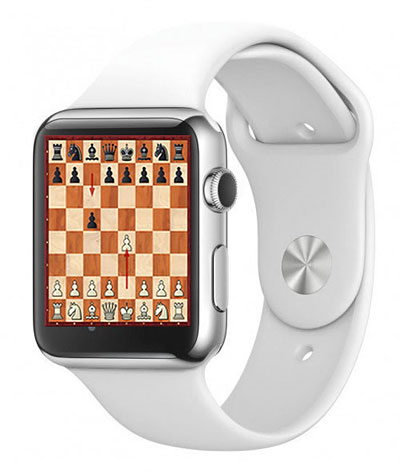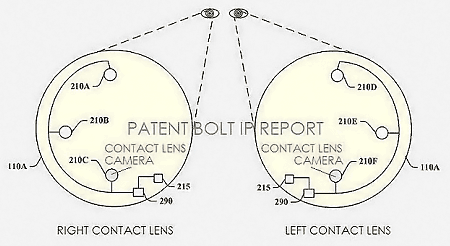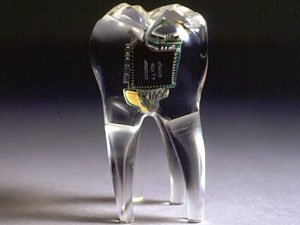
A wearable bundled with chess apps
By Frederic Friedel
Let us first discuss the hardware involved. Since we have friends whom we periodically visit at the Google headquarters in Mountain View, we were able to witness the Tooth project, right from the start. The first step was getting the hardware, a communications chip that connects to an Android phone, embedded into a (prosthetic) molar.

The device is implanted in the jaw in place of an extracted molar

In the initial test version, developed at the Department of Computer Science and Information Engineering at National Taiwan University in Taipei, the prosthetic tooth was connected by wires [Photo and report: Reuters]

Naturally one of the biggest problems is battery life. Experiments, carried out at the Canadian Abbott College research facilities, with a detachable crown sitting on an implanted stem, did not produce a viable solution.

Currently Google Tooth can be charged inductively, using a tiny pad inserted inside
the mouth for about fifteen minutes. A full charge lasts about half a day.
There is encouraging news, however, in form of an extremely low power technology that can be used in wearables. It is being developed by Atmel, a San Jose-based company, and is based on a new SAM L21 32-bit ARM family of microcontroller which consumes less than 35 microamps of power per megahertz of processing speed while active, and less than 200 nanoamps of power overall when in deep sleep mode – with varying states in between. The chip can even be powered off energy capture from the body, which boosts battery life. The hardware can theoretically run off a single battery charge for over ten years – or half a year in a device as small as Google Tooth.

The final version of a genuinely wearable Google Tooth. The commercial
version will be made of ceramic material and will be white.
One of the great advantages of Google Tooth is that it requires no external headphones or ear plugs – sound is transmitted directly from the device through the jaw bones to the ear. It is advisable to have two devices implanted, one on each side of the mouth, for full stereophonic audio which, we are told, is on par with a high-end headset.
Communicating with Google Tooth is done with voice – you simply speak softly as if to yourself. For instance saying "Okay Google" under your breath will, as in current Android smartphones, initiate a voice search. The answers are received through the audio jawbone feedback. Example: "Okay Google, do I need an umbrella tomorrow" will give you a weather report for your current location. And do we need to tell you how useful it is to be able to say "Okay Google, direct me to Sea World in San Diego" while driving down the highway?
The chess connection
One of the things the engineers used while testing of Google Tooth was chess software, running on external devices: Android smartphones, Android Watchs, and even on the latest Apple Watch.

This Apple Watch runs the chess program, a mobile version of Fritz,
while input and output are conduced by voice using Google Tooth

The smart phone or watch does not need to be in close proximity to the Tooth –
it can be located anywhere in the world, since communication can be conducted by WiFi
|
Google Tooth can be used to drive an app that connects it to the Playchess server, as we were able to demonstrate in our trial setup
We were even able to use Let's Check, Live Book and the Engine Cloud to get very high-quality analysis of running games, all controlled by whispered voice commands to Google Tooth.
Incidentally a well-known chess engine programmer is currently working on a system that would only require taps of the tongue to input moves – "in case the whispering is disturbing people around you." It is possible to play entire games that way. |
|
What the future will bring
Exciting as the above new wearable may be, the future may hold an even more alluring development in store. As we have discovered, Google has filed a US patent for embedding microscopic cameras into contact lenses, enabling the wearer to take photographs of their direct line of vision.

The patent details how wearers will be able to control the camera
through a sophisticated system using the owner's unique blinking patterns

Each lens will contain several tiny camera components and sensors without
obstructing the vision of the wearer [Source: The Telegraph, April 15, 2014]

Washington-based startup Innovega has developed the practical implementation of a natural eyewear-based platform. It is called iOptik and provides a 'virtual canvas' on which any media can be viewed or application run. Stephen Willey, Innovega CEO said: "Our optics deliver games that are truly 'immersive', movies that mimic IMAX performance, a multi-tasking dashboard that incorporates five or more typical screens – all while simultaneously providing the wearer a safe and clear view of their environment."

With appropriate software the contact lens input would be able to recognize chess positions...

... and Google Tooth would then provide the best move and Let's Check evaluation
(shown when you move the mouse over the image), all displayed in the contact lens.





































